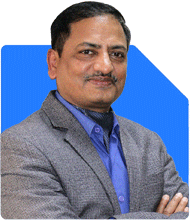Ramalingam Kalirajan |10017 Answers |Ask -Follow
Mutual Funds, Financial Planning Expert - Answered on May 26, 2024
He has an MBA in finance from the University of Madras and is a certified financial planner.
He is the director and chief financial planner at Holistic Investment, a Chennai-based firm that offers financial planning and wealth management advice.... more

Hi Samraat, ( My goal - 1 CR in next 10-15 year) As a beginner, I have been making SIP's since last 5 months in ( Parag P Flexi 2k Pm, Axis Small cap 2.5kPm, Motilal oswal midcap 1.5K, ICICI Pru Value Discovery 1 K ) total @7000 per month. returns are reasonable and good. (step up 30% every year). (Thanks for your earlier advice on these) . Going forward, >> Now for lumpsum I have identified 1. Nippon India power and Infra , ( as i want to invest in Power sectoral funds) 2. Canara Robeco Bluechip Equity fund ( Direct Growth @ 10000 initially) , I plan to add 5k Quarterly ntil i reach a reasonable lumpsum amount. Please share your valuable suggestions on my plan. Thanks,
Your SIP portfolio is well-diversified across different categories like flexi cap, small cap, mid cap, and value discovery funds. It's commendable that you've started your SIP journey, and the step-up strategy of increasing investments by 30% annually demonstrates a disciplined approach towards wealth accumulation.
Proposed Lump Sum Investments:
Nippon India Power and Infra Fund:
Investing in sectoral funds like power and infrastructure can offer growth opportunities, especially if you believe in the long-term prospects of this sector.
However, it's essential to note that sectoral funds can be volatile and carry higher risk compared to diversified equity funds.
Ensure that your investment horizon aligns with the inherent volatility of the power sector, and consider diversifying across other sectors for risk mitigation.
Canara Robeco Bluechip Equity Fund (Direct Growth):
Opting for a blue-chip equity fund is a prudent choice for investors seeking stability and consistent returns.
Blue-chip funds typically invest in large-cap stocks with strong fundamentals, making them relatively safer than mid and small-cap funds.
Your strategy of initially investing a lump sum followed by quarterly additions is a systematic way to build wealth over time.
Overall Recommendations:
Diversification:
While your selection of funds seems reasonable, consider further diversification across different asset classes like debt, gold, and international funds to mitigate risk.
Diversification helps in spreading risk and optimizing returns, especially during market uncertainties.
Regular Review:
It's essential to review your portfolio periodically, preferably annually or bi-annually, to ensure it remains aligned with your financial goals and risk tolerance.
Rebalancing your portfolio based on changing market conditions and your investment objectives is crucial for long-term wealth creation.
Risk Management:
As you progress towards your goal of accumulating Rs. 1 crore in the next 10-15 years, consider your risk appetite and adjust your investment strategy accordingly.
Ensure that your asset allocation reflects your risk tolerance and investment horizon to achieve a balance between growth and stability.
In conclusion, your investment plan demonstrates a proactive approach towards wealth creation. However, remember to stay informed about market developments and seek professional advice whenever necessary to make informed investment decisions.
Best Regards,
K. Ramalingam, MBA, CFP,
Chief Financial Planner,
www.holisticinvestment.in
You may like to see similar questions and answers below
Ulhas Joshi | Answer |Ask -Follow
Mutual Fund Expert - Answered on May 22, 2023
Sanjeev Govila | Answer |Ask -Follow
Financial Planner - Answered on Feb 06, 2024
Ramalingam Kalirajan |10017 Answers |Ask -Follow
Mutual Funds, Financial Planning Expert - Answered on May 30, 2024
Ramalingam Kalirajan |10017 Answers |Ask -Follow
Mutual Funds, Financial Planning Expert - Answered on Nov 18, 2024
Nayagam P P |9744 Answers |Ask -Follow
Career Counsellor - Answered on Jul 31, 2025
Radheshyam Zanwar |6014 Answers |Ask -Follow
MHT-CET, IIT-JEE, NEET-UG Expert - Answered on Jul 31, 2025
Nayagam P P |9744 Answers |Ask -Follow
Career Counsellor - Answered on Jul 31, 2025
Samraat Jadhav |2407 Answers |Ask -Follow
Stock Market Expert - Answered on Jul 31, 2025
Samraat Jadhav |2407 Answers |Ask -Follow
Stock Market Expert - Answered on Jul 31, 2025
Radheshyam Zanwar |6014 Answers |Ask -Follow
MHT-CET, IIT-JEE, NEET-UG Expert - Answered on Jul 31, 2025

Both are good options. Considering the opportunities in the tech field and the manpower demand, it is advisable to pursue AI+ML @ BIT Mesra for careers focused on software and AI.
Good luck.
Follow me if you receive this reply..
Radheshyam
Radheshyam Zanwar |6014 Answers |Ask -Follow
MHT-CET, IIT-JEE, NEET-UG Expert - Answered on Jul 31, 2025
Radheshyam Zanwar |6014 Answers |Ask -Follow
MHT-CET, IIT-JEE, NEET-UG Expert - Answered on Jul 31, 2025
Radheshyam Zanwar |6014 Answers |Ask -Follow
MHT-CET, IIT-JEE, NEET-UG Expert - Answered on Jul 31, 2025
Dr Nagarajan J S K |2107 Answers |Ask -Follow
NEET, Medical, Pharmacy Careers - Answered on Jul 31, 2025






















